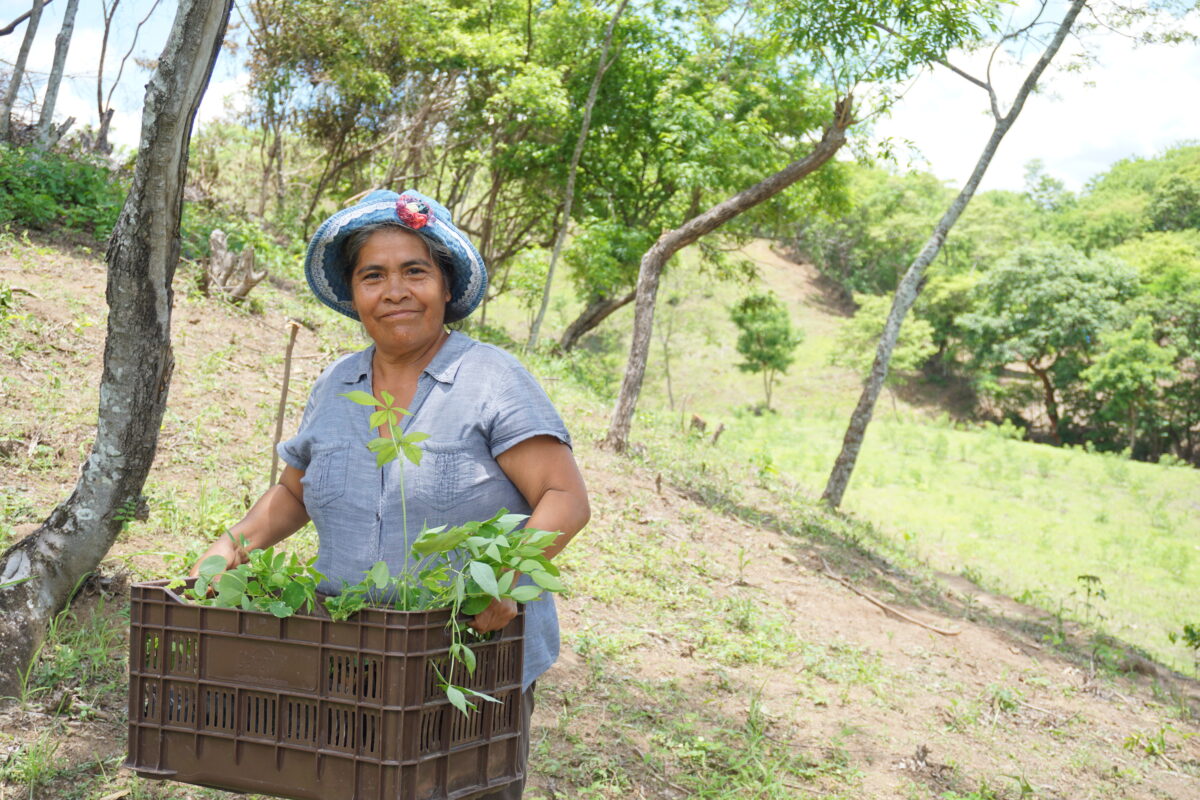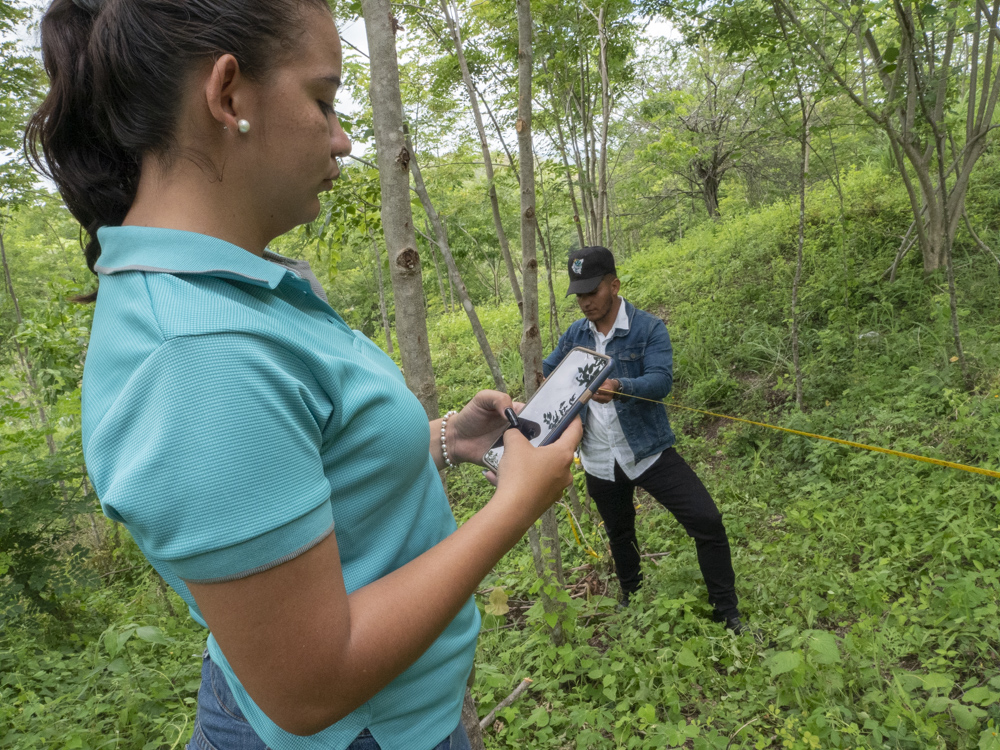Taking Root has released an updated Project Design Document (PDD) under version 4 of the Plan Vivo Carbon Standard to enable the expansion of the CommuniTree Carbon Program across Nicaragua. The updated PDD reflects the project’s latest best practices for community engagement, forest restoration, and monitoring and verification for the creation of high integrity carbon removals so that thousands of smallholder farmers can improve their livelihoods from growing trees.
What is the CommuniTree Program?
The CommuniTree Carbon Program in Nicaragua is Taking Root’s flagship smallholder forest restoration project. Together with local implementation partner APRODEIN, the project enables local farmers to benefit from growing trees. In the short term, benefit comes from the sale of carbon removals, helping farmers to cover the initial costs of establishing their forests. In the long term, benefit comes through new sustainable sources of income (such as sales of fuelwood, sustainable timber, and other agroforestry products like coffee and fruits) so that farmers are incentivised to successfully grow and manage their forests for the long term.
What is a Project Design Document (PDD)?
A PDD is a vital element of any carbon removal project. It provides a detailed description of how the project is designed and operates in line with market standards to create certified carbon removals. CommuniTree’s previous PDD was written under version 3 of the Plan Vivo Standard and was approved in 2014. A lot has changed since then. What began as a small-scale project in Nicaragua’s San Juan de Limay region has flourished into a country-wide program with international acclaim. This growth is testament to the project team’s ongoing commitment to learn from successes and challenges to strengthen the project’s operations, further utilize technology, and better engage with communities to effectively restore forests.
As outlined below, the PDD incorporates a number of updates regarding the project’s latest processes, methodologies, and documents to generate certified carbon removals under version 4 of the Plan Vivo Standard. Our hope is that this PDD will inspire others and offer an example of best practice when it comes to restoring nature and improving livelihoods at scale through the creation of high-integrity carbon removals.

Update 1: CommuniTree expands across Nicaragua
When CommuniTree was first certified in 2010, it was a small project in the north-west of Nicaragua. Now, it is growing trees with thousands of smallholder farmers across the entire country. CommuniTree has grown to such an extent that in 2019, it became the single largest reforestation initiative in Nicaragua.
The updated PDD introduces the project’s expansion into new regions, detailing CommuniTree’s approach to restoring forests in alignment with unique regional contexts and local communities. In addition, it integrates the processes required to operate the program at a greater scale. These reflect the efforts of Taking Root and APRODEIN to build capacity, design standard operating procedures, and create the program documentation needed to grow CommuniTree while continuing to improve program delivery for participating farmers and communities.
Taking Root’s Reforestation Partnerships (Nicaragua) Director, Laura Morillas PhD, says: “The updated PDD represents the current reality of CommuniTree, in that it is now a nationwide project. It is incredible to reflect on how much the project has grown since a handful of smallholder farmers started planting trees in Nicaragua all those years ago.”
Update 2: Use of technology to create high integrity carbon removals
Since the previous PDD was published in 2014, CommuniTree has continued to embrace a technological approach to enable farmers to successfully grow trees and deliver high integrity carbon removals. The new PDD documents the increased development and deployment of Taking Root’s management platform to give visibility and facilitate operations across the program. This includes updated field data collection practices through Taking Root’s mobile app and program reporting on Taking Root’s web platform. Combined, these are providing enhanced tracking and verification of farmer and land eligibility, the implementation of silvicultural activities, tree growth on parcels, and carbon sequestration over time.
In addition, the updated PDD has integrated CommuniTree’s latest forest technical specifications which were previously outlined in separate documentation. Technical specifications are the planting designs that farmers grow on one or more parcels of their land. In CommuniTree, these have been designed with input from local communities. They use native and naturalized tree species to complement farmers’ existing agricultural practices so that they provide value for farmers over time while restoring local ecosystems and benefitting local biodiversity.
“By incorporating all the CommuniTree program’s methodologies and technical specifications in one place, we hope to provide enhanced transparency and understanding as to how the project works,” explains David Baumann, Taking Root’s Methodologies & Standards Director. “Methodologies are the scientific frameworks used to calculate the impact of a carbon project and are key indicators that a project is producing high-quality carbon removals. The methodologies used by Taking Root have been meticulously developed with a focus on rigour and are outlined in the updated PDD.”

Update 3: Communities enshrined at the heart of restoration activities
There is another vital ingredient to the success of the CommuniTree program: its commitment to equity and engagement with local communities. As a community-led forest restoration project, local communities provided an input into the design of the program, receive 60% of carbon revenue, and play a vital role in implementing operations with a local team made up over 170 full-time employees and thousands of seasonal workers.
The updated PDD better speaks to the project’s emphasis on community participation and ongoing community engagement. This includes a detailed explanation of CommuniTree’s participatory project design. The PDD outlines how consultations are held before the project starts operating in a new area or community to learn about farmers’ interests, priorities, and shared values. This is followed by ongoing stakeholder engagement to ensure farmers join the program on the basis of free, prior, and informed consent. In addition, the PDD documents how continuous feedback is elicited from project participants and integrated where applicable to allow for ongoing project improvement in line with farmers’ needs. This includes an outline of CommuniTree’s community-based grievance mechanism, which provides farmers and other stakeholders with the opportunity to submit feedback, express concerns, and offer suggestions to continuously improve the project for participants.

What’s next for CommuniTree?
Together, the developments reflected in the updated PDD are enabling the CommuniTree program to scale its operations to restore forests with farmers and land across Nicaragua. This will unlock impact with thousands of farming families at a national scale, improving livelihoods and restoring local ecosystems while removing carbon from the atmosphere.
“Today, the CommuniTree Carbon Program is recognised as a leading project in forest restoration and ecosystem rehabilitation,” says Laura Morillas, PhD. “This is an amazing achievement, but we remain ambitious. Going forward, we are focused on continuing to scale our operations while enhancing the quality of our carbon removals, so we create as much impact as possible for smallholder farmers and nature across the country.”
Read CommuniTree’s Project Design Document in full and sign up to Taking Root’s newsletter for more project updates.